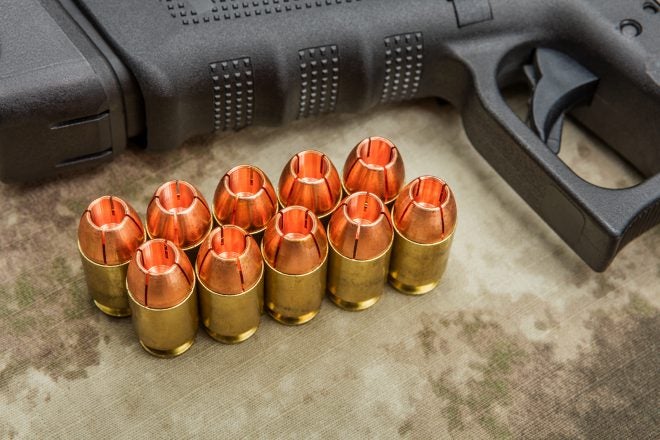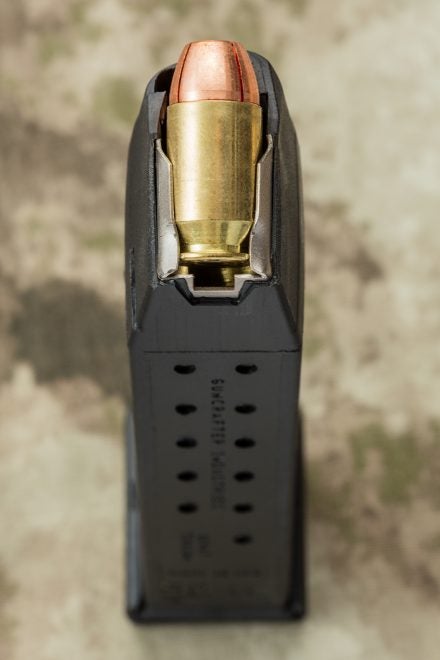The .50 Caliber Glock
Oleg Volk 12.12.16
The title makes it sound like a mad rave of an ignorant prohibitionist, but the .50 caliber Glocks are a reality. Guncrafter Industries makes conversion slides for G21 and G41 to take their 50GI cartridge. The slides are the budget alternative to the $4000 ultimate 1911 longslide, their Model 4. At $595 to $660, this gets a shooter into 50GI caliber at a rather lower price than the 1911 route.
Holding ten round in the slightly extended magazine or nine rounds in flush fitting one, this conversion gives up some capacity for the greater punch per shot. The theory behind this round is simple: why spend some of the kinetic energy to expand a projectile, when it can be launched already pre-expanded?
50GI is a low-pressure caliber along the lines of the classic .455 Webley. At the same pressure as 45ACP, it’s easy on the shooter and gives equally quick follow-up shots, something not observed with 50AE or 50S&W. The nominal range of expanding ammunition is 185gr at 1200fps to 275gr at 875fps, and a 300gr JSP is available for practice and for punching through tough wild animals. At 700fps, the 300gr load is on the same power level as 44 Special–a mild, easy shooting round that works well for rapid second and third hits if necessary. The expanding bullets are all optimized for thin-skinned humanoid foes, with the 230-grainer making holes a foot deep and almost an inch wide. Light for the caliber 185gr stops at 9″ but makes an even rather wider path. Actual chronographed velocities were very close from 4.5″ barrels and higher than spec from 5″-6″ tubes.
All-copper projectiles are fairly efficient about converting speed into expansion without fragmenting or folding the petals back onto themselves. Muzzle flash was minimal with all loads I tried (185, 230, 275 and 300).
As you can see, the rebated rim allows 45ACP sized breechface. The magazines are easy to load with just fingers. Depending on the load, the degree of muzzle flip was either minimal or slight, definitely on par with 45ACP experience. The one down side to the Glock conversion relative to the superb 1911 longslide was decreased accuracy. My 9-shot groups from standing at 10 yards were around 2.25″, while the 1911 with a longer sight radius and better trigger printed 7-shot groups inside an inch. Again, with the #4 longslide, the group size at ten yards was smaller than the size of the expanded bullet! With the Glocks, it was not quite as good, though the difference was probably more ergonomics than the mechanics of the devices.
Since 50GI ammunition is expensive, the expectation is that shooters train primarily with similarly handling 45ACP uppers and carry 50GI uppers. Given the similarity of the shooting experiences between the two calibers and the excellent reliability of the conversions, that’s a valid approach. Unlike the more energetic cartridges, like 10mm Auto and 44Mag, 50GI doesn’t wear out the shooter in training and is relatively sparing on unprotected hearing in subsonic loads.
Compared to stock Glock magazines, the conversion gives up quite a bit of capacity, from 13+1 to 8+1. Each bullet gains about 22% frontal area, both before and after expansion. The trade-off is up to you. Is it worth getting nine stronger hits before reloading, or to get five more shots before the mag switch is required?
As you can see, extended barrels are available. While they add only a bit of velocity, threading for suppressors is an option. While 50GI is currently available only from Guncrafter Industries, a number of handloading recipes provide for for even less mainstream loads. Fired brass can be reused quite a few times.

